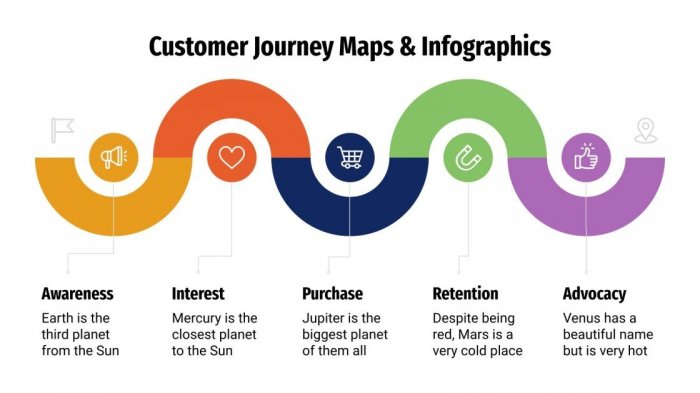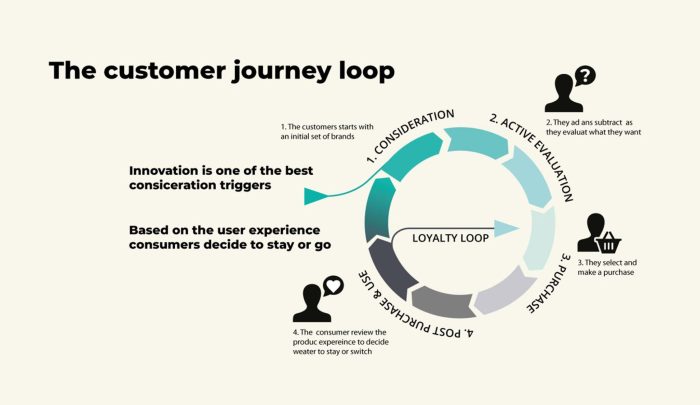Understanding the Customer Journey takes center stage in the business world, offering a roadmap to unlocking success. Get ready to dive deep into the realm of customer behavior and strategic insights.
Introduction to Customer Journey
In a business context, the customer journey refers to the entire process that a customer goes through when interacting with a company. This journey typically includes the initial awareness of a product or service, the decision-making process, the purchase, and post-purchase experience.
Understanding the customer journey is crucial for businesses as it allows them to gain insights into the needs, preferences, and behaviors of their customers. By mapping out the customer journey, businesses can identify pain points, optimize touchpoints, and create personalized experiences that enhance customer satisfaction and loyalty.
Importance of Mapping the Customer Journey
Mapping out the customer journey helps businesses:
- Identify key touchpoints where customers interact with the brand
- Understand customer behaviors and preferences at each stage of the journey
- Anticipate and address customer needs to provide a seamless experience
- Optimize marketing strategies and communication channels based on customer insights
Stages of the Customer Journey: Understanding The Customer Journey
When it comes to understanding the customer journey, it’s important to recognize the different stages that customers go through when interacting with a business. By identifying these stages and the key touchpoints within them, businesses can better tailor their marketing and customer service strategies to meet the needs of their customers.
Awareness Stage
The awareness stage is where potential customers first become aware of a product or service. This can happen through various channels such as social media, advertising, or word of mouth. Key touchpoints at this stage include social media ads, blog posts, and online reviews that introduce customers to the brand.
Evaluation Stage
During the evaluation stage, customers are considering whether or not to make a purchase. Key touchpoints at this stage include product demos, customer testimonials, and comparison shopping. Businesses can use this stage to provide valuable information that helps customers make informed decisions.
Purchase Stage
Once a customer has made the decision to purchase, they enter the purchase stage. Key touchpoints at this stage include the checkout process, customer service interactions, and post-purchase follow-ups. Businesses can focus on providing a seamless purchasing experience to encourage repeat business.
Post-Purchase Stage
The post-purchase stage is crucial for building customer loyalty. Key touchpoints at this stage include follow-up surveys, loyalty programs, and customer feedback channels. By engaging with customers after the purchase, businesses can gather valuable insights and foster long-term relationships.
Mapping the Customer Journey

When it comes to creating a customer journey map, businesses need to put on their detective hats and dive deep into the minds of their customers. It’s all about understanding the different touchpoints and interactions that customers have with the business, from the initial awareness stage to post-purchase follow-up.
Customer journey maps are like treasure maps for businesses. They help visualize the entire customer experience, pinpointing where customers are coming from, what they’re looking for, and how they feel at each stage of the journey. By mapping out these details, businesses can identify pain points, areas for improvement, and opportunities to delight customers along the way.
Key Elements of a Customer Journey Map
- Customer Personas: Creating detailed profiles of different types of customers to understand their needs and preferences.
- Touchpoints: Identifying all the interactions customers have with the business, both online and offline.
- Emotions: Capturing how customers feel at each stage of the journey, from excitement to frustration.
- Pain Points: Highlighting areas where customers face challenges or obstacles that need to be addressed.
- Opportunities: Identifying moments where businesses can exceed customer expectations and create memorable experiences.
Customer journey maps are not set in stone – they should be regularly updated and refined based on feedback, data, and changing customer behaviors.
Customer Personas
Customer personas are fictional representations of your ideal customers based on market research and real data about your existing customers. They help businesses understand their target audience better by creating detailed profiles that include demographics, behaviors, motivations, and goals. By identifying different customer personas, businesses can tailor their marketing strategies, products, and services to meet the specific needs and preferences of each persona.
How Businesses Use Customer Personas
Customer personas are valuable tools that businesses use to enhance their understanding of customers in various ways. Here are some examples of how businesses utilize customer personas:
- Personalizing Marketing Campaigns: Businesses can create targeted marketing campaigns that resonate with each customer persona by understanding their unique preferences and behaviors.
- Improving Product Development: By identifying the needs and pain points of different customer personas, businesses can develop products and services that address specific customer requirements.
- Enhancing Customer Experience: Customer personas help businesses tailor their customer service and support to meet the expectations of each persona, providing a more personalized and satisfying experience.
- Optimizing Communication Channels: Businesses can determine the most effective communication channels to reach each customer persona, whether through social media, email, or other platforms.
- Increasing Customer Retention: Understanding customer personas allows businesses to build stronger relationships with customers, leading to higher customer satisfaction and loyalty.
Customer Feedback and Data Analysis

Customer feedback is crucial at different stages of the customer journey as it provides valuable insights into customer preferences, pain points, and overall satisfaction levels. By collecting feedback, businesses can understand what is working well and where improvements are needed, helping to tailor their products or services to better meet customer needs.
The Importance of Customer Feedback:
- Identify pain points: Customer feedback helps in pinpointing areas where customers are facing challenges or dissatisfaction, allowing businesses to address these issues promptly.
- Improve customer experience: By listening to customer feedback, businesses can enhance their services or products to create a more seamless and enjoyable experience for customers.
- Build brand loyalty: Showing customers that their feedback is valued and acted upon can increase brand loyalty and customer retention rates.
Data Analysis in Understanding the Customer Journey:
Data analysis plays a crucial role in gaining insights into the customer journey as it allows businesses to track and analyze customer behavior, preferences, and interactions with the brand. By leveraging data, businesses can make informed decisions to optimize the customer journey and drive business growth.
- Identifying trends: Data analysis helps in identifying patterns and trends in customer behavior, enabling businesses to predict future customer actions and tailor their strategies accordingly.
- Personalization: By analyzing customer data, businesses can create personalized experiences for customers based on their preferences and past interactions with the brand.
- Measuring success: Data analysis allows businesses to track the effectiveness of their marketing campaigns, customer engagement initiatives, and overall customer journey, helping them make data-driven decisions for continuous improvement.
Omnichannel Customer Journey
In the age of omnichannel marketing, the customer journey has evolved to encompass multiple touchpoints across various channels. This approach focuses on providing a seamless and integrated experience for customers, regardless of the platform or device they use.
Evolution of Customer Journey
With the rise of omnichannel marketing, companies are leveraging multiple channels such as websites, social media, mobile apps, and physical stores to engage with customers. This ensures a consistent brand experience across all touchpoints, leading to increased customer satisfaction and loyalty.
- Companies like Starbucks have successfully implemented omnichannel strategies by allowing customers to order and pay through their mobile app, website, or in-store, creating a seamless experience.
- Retail giant Nordstrom provides customers with the option to buy online and pick up in-store, bridging the gap between digital and physical shopping experiences.
- Amazon is a prime example of omnichannel success, with its interconnected ecosystem of online shopping, Prime membership benefits, and physical stores like Whole Foods.
Improving Customer Experience
Enhancing the overall customer experience is crucial for businesses to build loyalty and increase customer satisfaction. By understanding the customer journey, companies can implement strategies that cater to the needs and preferences of their customers.
Personalization in Improving the Customer Journey
Personalization plays a key role in improving the customer journey by providing tailored experiences that resonate with individual customers. Here are some strategies to enhance the customer experience through personalization:
- Utilize customer data to create personalized recommendations and offers based on past interactions and preferences.
- Implement personalized communication channels such as targeted emails or messages to engage customers on a more personal level.
- Customize the user experience on your website or app by displaying relevant content and products based on the customer’s browsing history.
- Develop customer personas to better understand the needs and behaviors of different customer segments, allowing for more targeted and effective personalization strategies.